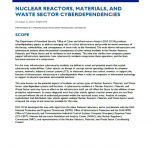DOE, NRC, and State are not able to fully account for U.S. nuclear material overseas that is subject to nuclear cooperation agreement terms because the agreements do not stipulate systematic reporting of such information, and there is no U.S. policy to pursue or obtain such information. Section 123 of the AEA, as amended, does not require nuclear cooperation agreements to contain provisions stipulating that partners report information on the amount, status, or location (facility) of special nuclear material subject to the agreement terms. However, U.S. nuclear cooperation agreements generally require that partners report inventory information upon request, although DOE and NRC have not systematically sought such data. We requested from multiple offices at DOE and NRC a current and comprehensive inventory of U.S. nuclear material overseas, to include country, site, or facility, and whether the quantity of material was rated as Category I or Category II material. However, neither agency has provided such an inventory. NMMSS does not contain the data necessary to maintain an inventory of U.S. special nuclear material overseas. DOE, NRC, and State have not pursued annual inventory reconciliations of nuclear material subject to U.S. cooperation agreement terms with all foreign partners that would provide the U.S. government with better information about where such material is held. Furthermore, according to DOE, NRC, and State officials, no U.S. law or policy directs U.S. agencies to obtain information regarding the location and disposition of U.S. nuclear material at foreign facilities.
Read more →

